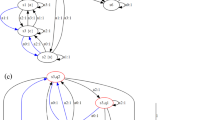Abstract
Timed PNs enhance modelling capability of PNs by modifying the basic PN semantics to model temporal relations and constraints of a system. This modification makes their analysis more difficult. For example, the existing techniques for reachability analysis of Time PNs is not well suited for dealing with the end-to-end timing issues, and PN based scheduling makes it difficult to use criteria other than makespan, e.g., tardiness. This paper proposes a class of PNs to model time that improves the current analysis techniques and overcomes these difficulties. Temporal constraints are modelled through arc weights that determine the enabling and firing of transitions to generate its reachability tree used for behavioural analysis as in PNs. All transitions fire instantaneously. Time is represented as a state of the system.
Similar content being viewed by others
References
Zhou MC, Venkatesh K (1999) Modelling, simulation, and control of flexible manufacturing systems: a petri net approach. World Scientific, Singapore
Wang J, Deng Y, Xu G (2000) Reachability analysis of real-time systems using time petri nets. IEEE Trans Sys Man Cyb Part B 30:725–736
Van Der Aalst WMP, Van Hee KM, Reijers HA (2000) Analysis of discrete-time stochastic petri nets. Stat Neerl 54:237–255
Wang J (1998) Timed petri nets: theory and application. Kluwer Academic, Norwell
Van Der Aalst WMP (1993) Interval timed coloured petri nets and their analysis. In Marsan A (ed) Application and theory of petri nets 1993. Lecture Notes in Computer Science, vol 691, Springer-Verlag, Berlin, pp 453–472
Richter G (1985) Clocks and their use for time modeling. In Sernadas A, Bubenko J, Olive A Jr (eds) Information systems: theoretical and formal aspects. North-Holland, Amsterdam, pp 49–66
Richter G (1998) Counting interfaces for discrete time modeling. GMD Report 26, GMD, Sankt Augustin. (http://www.gmd.de/endofservice/publications/report/0026/Text.pdf)
Salum L (2003) New perspectives in time(d) petri nets and their analysis. Proc. 2003 IEEE Control Applications Conference, Istanbul, pp 1041–1045
Jeetendra VA, Krishnaiah Chetty OV, Prashanth Reddy J (2000) Petri nets for project management and resource leveling. Int J Adv Manuf Technol 16:516–520
Salum L (2005) Project management through petri nets. Proc. 35th Int. Con. Computers and Industrial Engineering, Istanbul, pp 1669–1674
Author information
Authors and Affiliations
Corresponding author
Rights and permissions
About this article
Cite this article
Salum, L. Petri nets and time modelling. Int J Adv Manuf Technol 38, 377–382 (2008). https://doi.org/10.1007/s00170-007-1098-5
Received:
Accepted:
Published:
Issue Date:
DOI: https://doi.org/10.1007/s00170-007-1098-5




